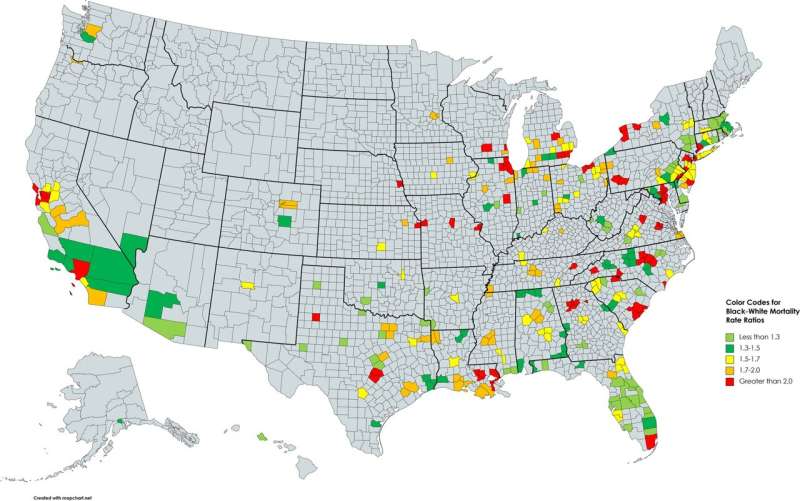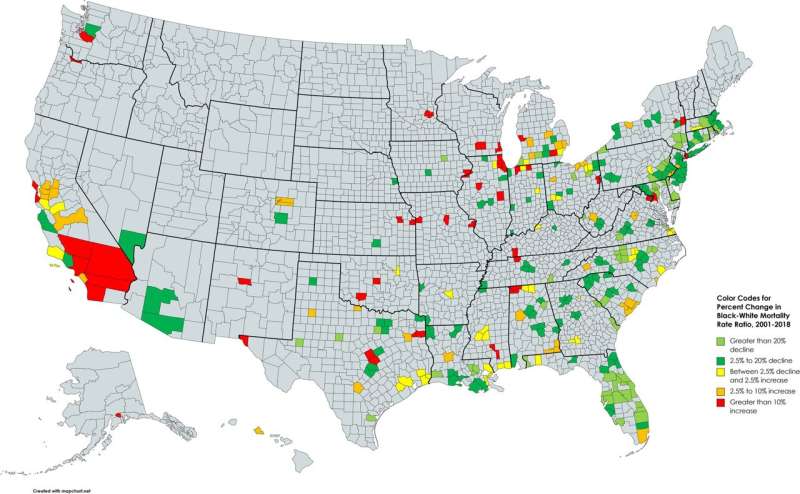This article has been reviewed according to Science X's editorial process and policies. Editors have highlighted the following attributes while ensuring the content's credibility:
fact-checked
trusted source
proofread
Reducing inequitable health outcomes requires reducing residential segregation, says study

The U.S. must reduce racial residential segregation if it is to reduce racial disparities in health outcomes, according to a recently published study by researchers at Tufts University School of Medicine. The research on 220 metropolitan areas nationwide between 1980 and 2020 found strong links between trends in racial residential segregation and racial disparities in early death rates from a variety of causes.
The study is the first known to examine the association between changes in racial segregation over time and long-term trends in mortality among non-Hispanic Black and non-Hispanic white people ages 65 or younger.
"This work shows that if we're able to reduce segregation in communities, we can also expect to reduce health disparities, which is a powerful insight for public health policy," said Michael Siegel, professor of public health and community medicine at the School of Medicine and lead author on the study published in the Journal of Racial and Ethnic Disparities. "It's not enough to simply identify disparities; we need to find evidence-based ways to reduce them."
Drawing on federal data on mortality and demographics in metropolitan statistical areas (MSAs), the study looked at changes in residential segregation between 1980 and 2000 and changes in health outcomes between 2001 and 2018, by which time the researchers hypothesized that measurable differences in mortality would be evident.
The researchers found that both baseline levels of racial residential segregation and ongoing changes in segregation accurately predicted trajectories in the racial disparity in death rates among people younger than age 65 from 12 common causes: breast cancer, colon cancer, lung cancer, prostate cancer, cerebrovascular disease, diabetes, genitourinary disease, HIV, hypertension, respiratory disease, pregnancy, and firearm homicide.

Striking was the fact that regardless of baseline levels in 1980, increases in levels of segregation between 1980 and 2000 boosted the likelihood that an MSA would be characterized by greater racial health disparities between 2001 and 2018, almost tripling that likelihood in some cases.
Data analysis characterized three groups of MSAs, two of which had lower levels of baseline segregation and showed slight declines over time in Black-to-white mortality disparities. These groups were projected to see the end of disparities by 2034 and 2075, respectively. The third group had the highest levels of baseline segregation and disparities in death rates and their trajectories rose over time, indicating that racial disparities will continue to worsen.
"These data do not support the notion that racism is a thing of the past or that we're in a post-racial society. In fact, for some people in some communities, things are getting worse," Siegel said. "Systemic racism, such as restrictive housing covenants and discriminatory 'redline' lending policies, created residential segregation, and equally purposeful change will be needed to eliminate segregation and associated health inequities."
The authors say that the study opens the door for further investigation to identify the best ways to reduce health disparities by combating residential segregation, and they suggest expansion of such research to include other races and ethnicities.
"I'm very excited about the additional research that our study will inspire," said Leighla Dergham, one of the paper's four graduate student authors, who is enrolled in the School of Medicine's physician assistant and master of public health dual-degree program. "By identifying an important entry point for meaningful interventions, our research will potentially have a great impact on future public health initiatives and policies to reduce racial health disparities associated with segregation."
More information: Michael Siegel et al, Association Between Changes in Racial Residential Segregation and Trends in Racial Disparities in Early Mortality in 220 Metropolitan Areas, 2001–2018, Journal of Racial and Ethnic Health Disparities (2023). DOI: 10.1007/s40615-023-01830-z



















